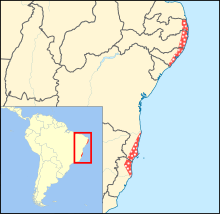| Blond capuchin | |
|---|---|

| |
| Scientific classification | |
| Domain: | Eukaryota |
| Kingdom: | Animalia |
| Phylum: | Chordata |
| Class: | Mammalia |
| Order: | Primates |
| Suborder: | Haplorhini |
| Infraorder: | Simiiformes |
| Family: | Cebidae |
| Genus: | Sapajus |
| Species: | S. flavius
|
| Binomial name | |
| Sapajus flavius (Schreber, 1774)
| |

| |
| Blond capuchin range | |
| Synonyms | |
|
Cebus queirozi Mendes Pontes and Malta, 2006 | |
The blond capuchin (Sapajus flavius) is a species of capuchin monkey endemic to northeastern Brazil. This endangered species was rediscovered in 2006. It can live in exceptionally large groups of over 150 individuals, and like other capuchin species, exhibits a complex and high level of sociality. It is threatened by loss of habitat due to agriculture, primarily sugarcane fields. In many cases this has caused sugarcane to make up a large portion of their diet, which would otherwise consist of mostly fruit and small animals. The blond capuchin is known to inhabit both the Atlantic forest and Caatinga biomes, although the habitation of the Caatinga may be a recent choice caused by human encroachment into its former habitats. Like other primate species, the blond capuchin is also threatened by poaching and capture for the illegal pet trade.
- ^ Valença-Montenegro, M.M.; Bezerra, B.M.; Martins, A.B.; Jerusalinsky, L.; Fialho, M.S.; Lynch Alfaro, J.W. (2021). "Sapajus flavius". IUCN Red List of Threatened Species. 2021: e.T136253A192592928. doi:10.2305/IUCN.UK.2021-1.RLTS.T136253A192592928.en. Retrieved 19 November 2021.
